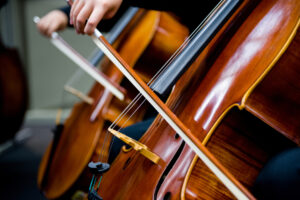As a cellist and cello teacher, I’ve often received the comment “I bet you wish you played the flute!” while transporting my instrument in its large, conspicuous white case in a taxi, train, subway, or even walking down the street. I’m often amused by this comment because while the flute is a beautiful instrument, I wouldn’t trade the cello for the world! This goes to show how the average person can be intimidated by the size of the cello. However, in my 15 years of playing the cello, I’ve found that while playing a larger instrument has its challenges, knowing some important basics for taking care of the cello makes instrument maintenance easy.
Lessons in Your Home teachers provide cello lessons in Washington DC that ensure the utmost care goes into keeping your cello free of damage and sounding great.
A Skilled Luthier
The most important thing with instrument maintenance is finding a skilled luthier. A luthier is the person who makes and repairs string instruments. In some areas this person might work in a violin shop or string shop, in others they might be available in a general music shop. In the Washington DC area, there are several local luthiers that provide excellent service. These businesses are often where beginner students go to rent their first instruments as well.
Luthiers are highly skilled and can give you great advice about maintaining your cello, fixing a repair, or even buying a cello, bow, or case. As we will learn, daily maintenance is quite important, but it is vital to know who to call when either the bow or the cello needs immediate repair.
Handle With Care
When I am teaching a new Lessons in Your Home cello student, no matter what the age, I make sure to give them instructions about how to keep their cello in good working shape and free from damage. Having seen many cellos break through the years, Washington DC cello teachers can spot an accident waiting to happen! Here are some important cello safety tips:
The bridge of the cello is not held in play by any glue or fastener, only the weight of the strings. At first glance, it may seem like the bridge won’t move out of place or break, but it absolutely can. In order to avoid any motion of or damage to the bridge, be sure to store and transport the cello so that it will not roll or fall onto its bridge. This is especially important for cellos in soft cases, which do not provide as much protection. When you are not using the cello, make sure it is resting on its side with the endpin put in. This will protect anyone from knocking it over onto the bridge.
You won’t believe how many people I’ve seen balance the cello upright on a wall or chair, where it can fall from a greater height and do more damage! Also, when transporting the cello, make sure the straps, clasps, or zippers are all fastened and secure. I’ve heard or seen several instances when case straps suddenly break and a cello falls off the cellist’s back and the neck snaps off.
(Don’t) Turn Up The Heat
Be aware of the temperature, humidity, and sunlight conditions around the cello. I like to tell students that cellos are generally okay in any temperature that people are ok in. That means if it’s too hot or cold for you outside, then it’s too hot or cold for the cello. This usually isn’t an issue inside the house, but be aware of the temperature in the car when transporting the cello to a lesson or concert! Even the trunk of a sedan may be too cold for the cello in the winter because it doesn’t receive heat like the parts of the car where the passengers are. Additionally, low humidity in the winter time can be dangerous for cellos, but that can be remedied with an instrument or case humidifier that can be purchased at most music shops. Lastly, make sure not to have the instrument in direct sunlight for too long as it can be bad for the varnish on the wood.
For me, I might encounter this problem when playing at an outdoor event like a wedding, so in those instances you must make sure there is adequate cover for your instrument.
Stay In Tune
This seems like an obvious one, but making sure the cello is always in tune is very important for the health of the instrument and the strings.
Keep It Clean
Make sure to clean the rosin and dust off the strings with a dry cloth. NEVER use any kind of liquid or cleaning substance to clean your cello, as it could damage the varnish.
Tip Top Shape
Lessons in Your Home cellists teach their students about all the necessary basic maintenance that is required when playing the cello. This includes re-hairing the bow, checking for open seams, and changing strings periodically. Once a student has been playing for several months or a year, they will learn how to spot the need for maintenance. Changing old strings or getting new hair on the bow will guarantee that the cello will be sounding its best!
With these tips, you can be certain your cello will be in great shape for lessons, concerts, and recitals for years to come! For more cello tips or to find a teacher to fit your needs, contact Lessons in Your Home today to find a Washington DC cello teacher near you! Our teachers will come right to your home for every lesson, plus we offer virtual music lessons, too. Our online music lessons are taught by local music teachers who tailor their lessons specifically for your child. Contact us today to learn more.
by Emily Doveala
